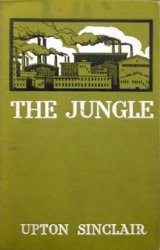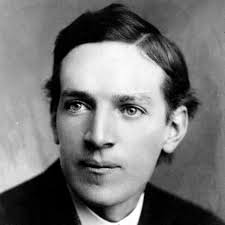The Jungle Page #13
The Jungle is a 1906 novel by the American journalist and novelist Upton Sinclair. Sinclair wrote the novel to portray the harsh conditions and exploited lives of immigrants in the United States in Chicago and similar industrialized cities.
Before the carcass was admitted here, however, it had to pass a government inspector, who sat in the doorway and felt of the glands in the neck for tuberculosis. This government inspector did not have the manner of a man who was worked to death; he was apparently not haunted by a fear that the hog might get by him before he had finished his testing. If you were a sociable person, he was quite willing to enter into conversation with you, and to explain to you the deadly nature of the ptomaines which are found in tubercular pork; and while he was talking with you you could hardly be so ungrateful as to notice that a dozen carcasses were passing him untouched. This inspector wore a blue uniform, with brass buttons, and he gave an atmosphere of authority to the scene, and, as it were, put the stamp of official approval upon the things which were done in Durham's. Jurgis went down the line with the rest of the visitors, staring open-mouthed, lost in wonder. He had dressed hogs himself in the forest of Lithuania; but he had never expected to live to see one hog dressed by several hundred men. It was like a wonderful poem to him, and he took it all in guilelessly--even to the conspicuous signs demanding immaculate cleanliness of the employees. Jurgis was vexed when the cynical Jokubas translated these signs with sarcastic comments, offering to take them to the secret rooms where the spoiled meats went to be doctored. The party descended to the next floor, where the various waste materials were treated. Here came the entrails, to be scraped and washed clean for sausage casings; men and women worked here in the midst of a sickening stench, which caused the visitors to hasten by, gasping. To another room came all the scraps to be “tanked,” which meant boiling and pumping off the grease to make soap and lard; below they took out the refuse, and this, too, was a region in which the visitors did not linger. In still other places men were engaged in cutting up the carcasses that had been through the chilling rooms. First there were the “splitters,” the most expert workmen in the plant, who earned as high as fifty cents an hour, and did not a thing all day except chop hogs down the middle. Then there were “cleaver men,” great giants with muscles of iron; each had two men to attend him--to slide the half carcass in front of him on the table, and hold it while he chopped it, and then turn each piece so that he might chop it once more. His cleaver had a blade about two feet long, and he never made but one cut; he made it so neatly, too, that his implement did not smite through and dull itself--there was just enough force for a perfect cut, and no more. So through various yawning holes there slipped to the floor below--to one room hams, to another forequarters, to another sides of pork. One might go down to this floor and see the pickling rooms, where the hams were put into vats, and the great smoke rooms, with their airtight iron doors. In other rooms they prepared salt pork--there were whole cellars full of it, built up in great towers to the ceiling. In yet other rooms they were putting up meats in boxes and barrels, and wrapping hams and bacon in oiled paper, sealing and labeling and sewing them. From the doors of these rooms went men with loaded trucks, to the platform where freight cars were waiting to be filled; and one went out there and realized with a start that he had come at last to the ground floor of this enormous building. Then the party went across the street to where they did the killing of beef--where every hour they turned four or five hundred cattle into meat. Unlike the place they had left, all this work was done on one floor; and instead of there being one line of carcasses which moved to the workmen, there were fifteen or twenty lines, and the men moved from one to another of these. This made a scene of intense activity, a picture of human power wonderful to watch. It was all in one great room, like a circus amphitheater, with a gallery for visitors running over the center. Along one side of the room ran a narrow gallery, a few feet from the floor; into which gallery the cattle were driven by men with goads which gave them electric shocks. Once crowded in here, the creatures were prisoned, each in a separate pen, by gates that shut, leaving them no room to turn around; and while they stood bellowing and plunging, over the top of the pen there leaned one of the “knockers,” armed with a sledge hammer, and watching for a chance to deal a blow. The room echoed with the thuds in quick succession, and the stamping and kicking of the steers. The instant the animal had fallen, the “knocker” passed on to another; while a second man raised a lever, and the side of the pen was raised, and the animal, still kicking and struggling, slid out to the “killing bed.” Here a man put shackles about one leg, and pressed another lever, and the body was jerked up into the air. There were fifteen or twenty such pens, and it was a matter of only a couple of minutes to knock fifteen or twenty cattle and roll them out. Then once more the gates were opened, and another lot rushed in; and so out of each pen there rolled a steady stream of carcasses, which the men upon the killing beds had to get out of the way. The manner in which they did this was something to be seen and never forgotten. They worked with furious intensity, literally upon the run--at a pace with which there is nothing to be compared except a football game. It was all highly specialized labor, each man having his task to do; generally this would consist of only two or three specific cuts, and he would pass down the line of fifteen or twenty carcasses, making these cuts upon each. First there came the “butcher,” to bleed them; this meant one swift stroke, so swift that you could not see it--only the flash of the knife; and before you could realize it, the man had darted on to the next line, and a stream of bright red was pouring out upon the floor. This floor was half an inch deep with blood, in spite of the best efforts of men who kept shoveling it through holes; it must have made the floor slippery, but no one could have guessed this by watching the men at work. The carcass hung for a few minutes to bleed; there was no time lost, however, for there were several hanging in each line, and one was always ready. It was let down to the ground, and there came the “headsman,” whose task it was to sever the head, with two or three swift strokes. Then came the “floorsman,” to make the first cut in the skin; and then another to finish ripping the skin down the center; and then half a dozen more in swift succession, to finish the skinning. After they were through, the carcass was again swung up; and while a man with a stick examined the skin, to make sure that it had not been cut, and another rolled it up and tumbled it through one of the inevitable holes in the floor, the beef proceeded on its journey. There were men to cut it, and men to split it, and men to gut it and scrape it clean inside. There were some with hose which threw jets of boiling water upon it, and others who removed the feet and added the final touches. In the end, as with the hogs, the finished beef was run into the chilling room, to hang its appointed time.
Translation
Translate and read this book in other languages:
Select another language:
- - Select -
- 简体中文 (Chinese - Simplified)
- 繁體中文 (Chinese - Traditional)
- Español (Spanish)
- Esperanto (Esperanto)
- 日本語 (Japanese)
- Português (Portuguese)
- Deutsch (German)
- العربية (Arabic)
- Français (French)
- Русский (Russian)
- ಕನ್ನಡ (Kannada)
- 한국어 (Korean)
- עברית (Hebrew)
- Gaeilge (Irish)
- Українська (Ukrainian)
- اردو (Urdu)
- Magyar (Hungarian)
- मानक हिन्दी (Hindi)
- Indonesia (Indonesian)
- Italiano (Italian)
- தமிழ் (Tamil)
- Türkçe (Turkish)
- తెలుగు (Telugu)
- ภาษาไทย (Thai)
- Tiếng Việt (Vietnamese)
- Čeština (Czech)
- Polski (Polish)
- Bahasa Indonesia (Indonesian)
- Românește (Romanian)
- Nederlands (Dutch)
- Ελληνικά (Greek)
- Latinum (Latin)
- Svenska (Swedish)
- Dansk (Danish)
- Suomi (Finnish)
- فارسی (Persian)
- ייִדיש (Yiddish)
- հայերեն (Armenian)
- Norsk (Norwegian)
- English (English)
Citation
Use the citation below to add this book to your bibliography:
Style:MLAChicagoAPA
"The Jungle Books." Literature.com. STANDS4 LLC, 2025. Web. 10 Jan. 2025. <https://www.literature.com/book/the_jungle_272>.




Discuss this The Jungle book with the community:
Report Comment
We're doing our best to make sure our content is useful, accurate and safe.
If by any chance you spot an inappropriate comment while navigating through our website please use this form to let us know, and we'll take care of it shortly.
Attachment
You need to be logged in to favorite.
Log In